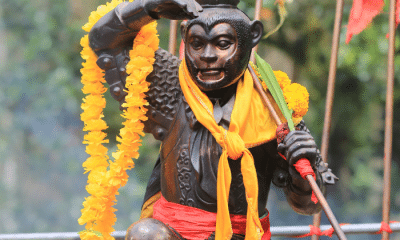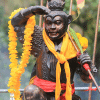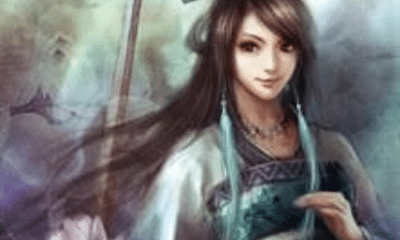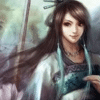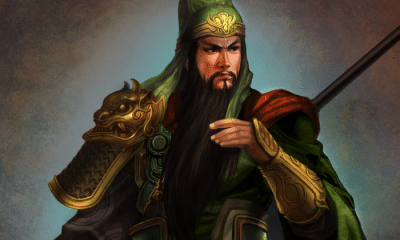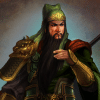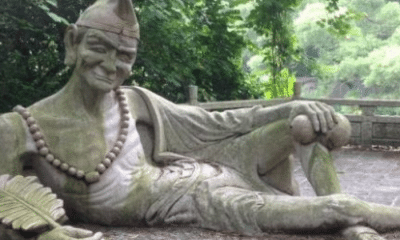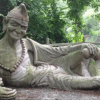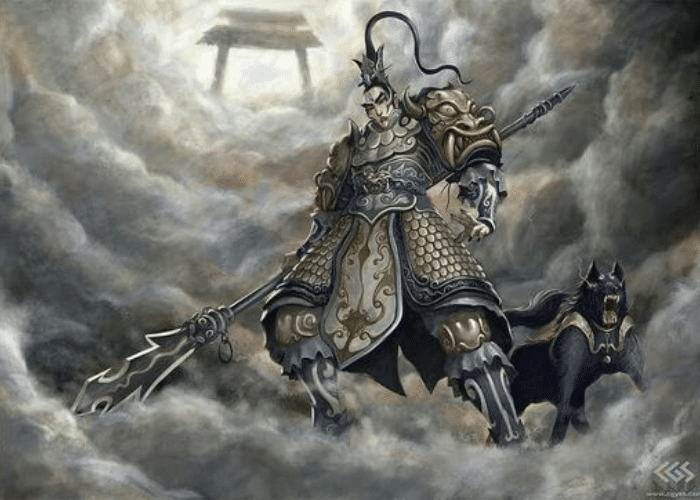
Chinese
Erlang Shen: The Chinese God of Decency and Truth
Erlang Shen: The Chinese God of Decency and Truth
Erlang Shen is often called the god of truth, but this is a very late addition to his story. Read more to learn how a skilled engineer became the champion of Heaven!
The most popular stories of Erlang Shen show him as a divine warrior. He fights for truth in the name of the Jade Emperor.
Erlang Shen sees the truth in things through the magic of his third eye, which can discern any falsehoods or illusions. He is a powerful warrior, a virtuous god, and a paragon of filial devotion.
While this is a popular depiction of the god, it is not how he was seen through most of Chinese history.
The stories of Erlang Shen fighting in Heaven were written in the 15th century. His original story was much less action-packed.
The earliest incarnation of Erlang Shen was not a warrior, but a thinker. As one of China’s first great engineers, he devised a system to both bring water to farmers’ fields and prevent disastrous floods in the Min River valley.
Over time, his legend grew to include slaying a dragon and ascending as a god. In a process typical in Taoist folklore, Erlang Shen grew from historical fact to legendary fiction.
The Many Flood Myths of Erlang Shen
Erlang Shen is a god of truth and priority in Chinese belief. While many myths exist about him, he is most well-known as a featured character in the novels of the 16th century Ming Dynasty.
In Investiture of the Gods and Journey to the West, Erlang Shen is characterized as a nephew of the Jade Emperor.
Journey to the West shows Erlang Shen as an opponent of Sun Wukong, the Monkey King. When Sun Wukong wreaks havoc in Heaven, Erlang Shen is charged with subduing him so he can be punished and expelled from Heaven.
The two fight a well-matched duel. While Erlang Shen is a more noble and skilled swordsman, the Monkey King uses his wits to constantly match him.
Eventually, Erlang Shen is about to subdue the Monkey King by working together with the other gods. While Sun Wukong denounces this as cheating in a one-on-one duel, Erlang is the victor.
One of the tools Erlang Shen was able to use in the fight was his third eye. It allowed him to see Sun Wukong’s true form behind an attempted illusion.
Erlang Shen’s third eye was his mark as a god of truth. In any situation, its magical sight allowed him to see that which was real and discern falsehoods.
In many other stories, however, Erlang Shen is not known under the same name. He is associated with several other characters in both literature and mythology.
In Investiture of the Gods, he goes by the name Yang Jian. He was again a nephew of the Jade Emperor, but his mother was imprisoned in a mountain for the crime of marrying a human.
Yang Jian was a heroic champion of the Jade Emperor. When the Diablo Brothers attacked the Western Foothills, he dueled all four at once.
During the duel, he allowed himself to be swallowed by the flying mink that accompanied the brothers. He killed the animal by shapeshifting inside of it, then took its form to steal their greatest weapon.
Yang Jian also heroically saved his mother. He cleaved the mountain she was locked within in two using his axe, then carried it on his back to chase away the sun in an act of filial devotion.
In many stories from other sources, Erlang Shen is closely associated with floods.
As Li Erlang, he was born to a human father during the Qin dynasty. He and his father were elevated to godhood by the people for developing a complex irrigation system that prevented the Min River from flooding.
Before the irrigation system could be designed, however, the pair had to discover the source of the flooding. Li Erlang journeyed across the region to find the problem.
Eventually, he and seven companions came across an old woman, Grandma Wang, whose grandson would soon be sacrificed to the evil local dragon. Realizing that the river dragon was the source of the flooding, Li Erlang agreed to help the woman.
He waited in the dragon’s temple to attack it when it emerged to claim its sacrifice. Although the dragon tried to flee, Grandma Wang provided a set of heavy iron chains that held it down.
The dragon was secured in a pool, making the area safe from floods.
Erlang Shen was also identified as Li Bing. China’s first hydraulic engineer, his story provides an alternate version of the construction of the Min River’s flood control system.
Like Li Erlang, Li Bing’s story grew to include the defeat of a river god. In thanks, the people of the area elevated him as their new river god who protected them instead of sending destructive floods.
In another associated story, Zhao Yu was a hermit who was made the governor of Jiazhou. He led 1,000 men against a local river dragon who was causing floods, but ended up beheading the serpent on his own.
Local legends claimed that the floods resumed after Zhao Yu’s death. When he was seen riding a white horse through the water, the locals built a temple in his honor and the floods ended for good.
The various stories associated with Erlang Shen may seem contradictory and confusing, but they represent the way in which many Chinese legends and gods developed over time.
My Modern Interpretation
The stories of Erlang Shen as a nephew of the Jade Emperor arose at a much later period in Chinese history than the other legends associated with him.
The Min Dynasty was a time of cultural innovation in China. Literature and the arts flourished and took liberties with well-known stories.
Many legends were almost entirely rewritten in Min novels and plays. Characters like Erlang Shen are almost unrecognizable from their earlier forms.
To interpret the character of Erlang Shen, therefore, it is important to look past these popular stories and into the more ancient myths.
The older stories of Erlang Shen share many similarities. Although they take place in different regions and eras, the main character defeats a dragon to prevent disastrous floods.
These stories are likely based on historical facts.
Many regions of China were prone to flooding in the country’s early history. Even today, China’s terrain and numerous waterways make it prone to natural disasters.
China was one of the first cultures to undertake large-scale engineering projects to substantially change the landscape for human benefit. This was possible not only because of the power and wealth of the state government but also because of the skills of their engineers.
Ancient Chinese engineering was as advanced that many of their constructions are still in use today. Li Bing’s irrigation system is still in use today, over 2,000 years after it was first created.
The skilled engineers who designed these systems came to be viewed as cultural heroes. Like great warriors and kings, they were revered to the point of deification.
In the Taoist tradition, most gods are born human. They are made immortal as a reward for showing exceptional virtue or accomplishing great feats.
Over time, this deification led to the stories of these characters becoming more involved and fabulous. They were elevated to become great warriors as well as brilliant engineers.
Dragons are often shown as river gods in Chinese culture, so the defeat of a dragon was a logical way to end flooding. The practical construction of an irrigation system became a legendary tale of a heroic battle.
The characters identified as Erlang Shen likely represent the real engineers who oversaw the construction of China’s earliest flood control projects. While details of their stories, such as their names, changed, they all represent man’s victory over the destructive forces of nature.
The name Erlang Shen was the divine name given to the figure as a god. Like most Taoist immortals, his name and tasks changed after he was deified.
Recognition that Erlang Shen was a title rather than a given name can be found in another flood story from the Jin Dynasty. After defeating a dragon god, General Deng Xia was renamed Erlang Shen to show his connection to the already legendary figure.
He may also have been believed to be a reincarnation of the first Erlang Shen.
When a god appears in many human forms, this is often interpreted as a sign of reincarnation rather than similarities between local legends or changes over time. It is believed that the Jade Emperor sometimes sends the immortals back to earth when they are needed.
The multiple Erlang Shens could, therefore, be interpreted as separate lives of the same character. Four hundred years after the Min River irrigation system was built, its engineer came back as a warrior to defeat another flood threat.
Min Dynasty authors seized on this idea to show familiar characters in truly divine forms. The version of Erlang Shen shown in Journey to the West and Investiture of the Gods could have been explained as the god’s true form in Heaven instead of the mundane human forms he had been incarnated as.
In Summary
The most popular stories of Erlang Shen are in the novels of the Min Dynasty. These books show him as the three-eyed god of truth who fights duels as the Jade Emperor’s champion.
While these stories feature existing characters, however, they are far removed from the origins of Erlang Shen’s legend.
Although different versions of the story provide different details, including different names, several legends identify Erlang Shen as a god who protects against floods.
A human engineer of early China, Erlang Shen is usually said to have lived and worked in the area of the Min River. When the river continuously flooded, he was tasked with solving the problem.
Later stories featured Erlang Shen’s battles against dragons as an allegory for how the river was actually tamed. In reality, skilled engineers used the authority and wealth of the state to construct an irrigation system that prevented most floods while also providing water for crops.
This system was so well-designed that it is still in use over 2,000 years after it was first built. The engineers responsible have passed into legend as deified cultural heroes.


